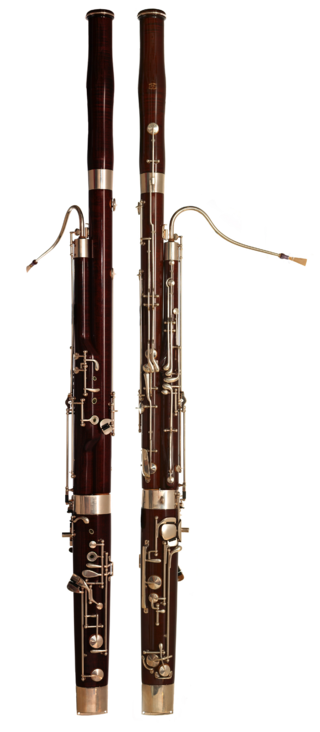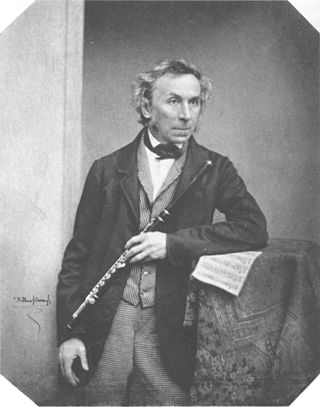Related Research Articles

The bassoon is a musical instrument in the woodwind family, which plays in the tenor and bass ranges. It is composed of six pieces, and is usually made of wood. It is known for its distinctive tone color, wide range, versatility, and virtuosity. It is a non-transposing instrument and typically its music is written in the bass and tenor clefs, and sometimes in the treble. There are two forms of modern bassoon: the Buffet and Heckel systems. It is typically played while sitting using a seat strap, but can be played while standing if the player has a harness to hold the instrument. Sound is produced by rolling both lips over the reed and blowing direct air pressure to cause the reed to vibrate. Its fingering system can be quite complex when compared to those of other instruments. Appearing in its modern form in the 19th century, the bassoon figures prominently in orchestral, concert band, and chamber music literature, and is occasionally heard in pop, rock, and jazz settings as well. One who plays a bassoon is called a bassoonist.
The clarinet is a single-reed musical instrument in the woodwind family, with a nearly cylindrical bore and a flared bell.

The saxophone is a type of single-reed woodwind instrument with a conical body, usually made of brass. As with all single-reed instruments, sound is produced when a reed on a mouthpiece vibrates to produce a sound wave inside the instrument's body. The pitch is controlled by opening and closing holes in the body to change the effective length of the tube. The holes are closed by leather pads attached to keys operated by the player. Saxophones are made in various sizes and are almost always treated as transposing instruments. A person who plays the saxophone is called a saxophonist or saxist.

The bass clarinet is a musical instrument of the clarinet family. Like the more common soprano B♭ clarinet, it is usually pitched in B♭, but it plays notes an octave below the soprano B♭ clarinet. Bass clarinets in other keys, notably C and A, also exist, but are very rare. Bass clarinets regularly perform in orchestras, wind ensembles and concert bands, and occasionally in marching bands, and play an occasional solo role in contemporary music and jazz in particular.

The basset clarinet is member of the clarinet family similar to the usual soprano clarinet but longer and with additional keys to enable playing several additional lower notes. Typically a basset clarinet has keywork going to a low (written) C or B, as opposed to the standard clarinet's E or E♭. The basset clarinet is most commonly a transposing instrument in A, although basset clarinets in C and B♭ and very seldom in G also exist. The similarly named basset horn is also a clarinet with extended lower range, but is in a lower pitch ; the basset horn predates, and undoubtedly inspired, the basset clarinet.

The contrabass clarinet (also pedal clarinet, after the pedals of pipe organs) and contra-alto clarinet are the two largest members of the clarinet family that are in common usage. Modern contrabass clarinets are transposing instruments pitched in B♭, sounding two octaves lower than the common B♭ soprano clarinet and one octave below the bass clarinet. Some contrabass clarinet models have extra keys to extend the range down to low written E♭3, D3 or C3. This gives a tessitura written range, notated in treble clef, of C3 – F6, which sounds B♭0 – E♭4. Some early instruments were pitched in C; Arnold Schoenberg's Fünf Orchesterstücke specifies a contrabass clarinet in A, but there is no evidence such an instrument has ever existed.

The contra-alto clarinet, E♭ contrabass clarinet, is a large clarinet pitched a perfect fifth below the B♭ bass clarinet. It is a transposing instrument in E♭ sounding an octave and a major sixth below its written pitch, between the bass clarinet and the B♭ contrabass clarinet.

Theobald Böhm was a German inventor and musician, who greatly improved the modern Western concert flute and its fingering system. He was a Bavarian court musician, a virtuoso flautist and a renowned composer.
The Western concert flute is a family of transverse (side-blown) woodwind instruments made of metal or wood. It is the most common variant of the flute. A musician who plays the flute is called a “flautist” in British English, and a “flutist” in American English.

The Oehler system is a system for clarinet keys developed by Oskar Oehler. Based on the Müller system clarinet, the system adds tone holes to correct intonation and acoustic deficiencies, notably of the alternately-fingered notes B♭ and F. The system has more keys than the Böhm system, up to 27 in the Voll-Oehler system. It also has a narrower bore and a longer, narrower mouthpiece leading to a slightly different sound. It is used mostly in Germany and Austria. Major developments include the patent C♯, low E-F correction, fork-F/B♭ correction and fork B♭ correction. Fingering charts can be found for example in this reference.
The Buescher Band Instrument Company was a manufacturer of musical instruments in Elkhart, Indiana, from 1894 to 1963. The company was acquired by the H&A Selmer Company in 1963. Selmer retired the Buescher brand in 1983.
Altissimo is the uppermost register on woodwind instruments. For clarinets, which overblow on odd harmonics, the altissimo notes are those based on the fifth, seventh, and higher harmonics. For other woodwinds, the altissimo notes are those based on the third, fourth, and higher harmonics. The altissimo register is also known as the high register.
In music, fingering, or on stringed instruments sometimes also called stopping, is the choice of which fingers and hand positions to use when playing certain musical instruments. Fingering typically changes throughout a piece; the challenge of choosing good fingering for a piece is to make the hand movements as comfortable as possible without changing hand position too often. A fingering can be the result of the working process of the composer, who puts it into the manuscript, an editor, who adds it into the printed score, or the performer, who puts his or her own fingering in the score or in performance.
Fingering...also stopping...(1) A system of symbols for the fingers of the hand used to associate specific notes with specific fingers....(2)Control of finger movements and position to achieve physiological efficiency, acoustical accuracy [frequency and amplitude] and musical articulation.
The Boehm system for the clarinet is a system of clarinet keywork, developed between 1839 and 1843 by Hyacinthe Klosé and Auguste Buffet jeune. The name is somewhat deceptive; the system was inspired by Theobald Boehm's system for the flute, but necessarily differs from it, since the clarinet overblows at the twelfth rather than the flute's octave. Boehm himself was not involved in its development.
A saxonette is a soprano clarinet in C, A, or B♭ that has both a curved barrel and an upturned bell, both usually made of metal. It has the approximate overall shape of a saxophone, but unlike that instrument it has a cylindrical bore and overblows by a twelfth. The instrument is also known as the 'Claribel' and 'Clariphon'. First Produced by Buescher Band Instrument Company between 1918 and 1921 under the name Clariphone.
The register key is a key on the clarinet that is used to play in the second register; that is, it raises the pitch of most first-register notes by a twelfth (19 semitones) when pressed. It is positioned above the left thumb hole and is operated by the left thumb. The same key used in combination with the left first finger key which produces the written note A4 (in scientific pitch notation) is used to play B♭4. Some clarinets, particularly bass clarinets and lower, have separate keys, or a more complex key mechanism, to control two or three separate holes for playing B♭, for playing the lower notes of the second register, and for playing the upper notes of the second register.

The five-key flute is a musical instrument once common in school marching bands, and composed of wood with metal keys. It is a transposing instrument, most commonly in A♭, this variant being known as the B♭ flute, named after its lowest note and sounding a minor sixth below the orchestral piccolo. The next most common variants are the E♭ piccolo, sounding a fifth above the B♭ flute, and the F flute, sounding a fifth below the B♭ flute. The E♭ piccolo is used for ornamentation in melodies and the F flute is used as a bass instrument in flute band harmonies. They are now often found in British military corps of drums, often playing various regimental marches.

The Reform Boehm system is a fingering system for the clarinet based on the Boehm system. It was developed to produce clarinets with the Boehm keywork but with a sound similar to a German clarinet.

Backun Musical Services Ltd. (BMS) is a Canadian manufacturer of clarinets in B♭ and A and accessories, based in Burnaby, British Columbia.

A thumb rest is a device that helps the player of certain woodwind instruments to keep them in the correct position and to facilitate his playing. The instruments are mainly clarinets, oboes, saxophones and flutes.
References
- ↑ US 2867146,Rosario, Mazzeo,"Clarinet",published 1959-01-06
- ↑ "Selmer announces a successor to the Boehm clarinet" (advertisement). Music Educators Journal 46:1 (September-October 1959), 10.
- ↑ "I believe in years to come we'll all be playing plastic instruments like this" (Selmer advertisement). Music Educators Journal 62:1 (September-October 1975), 88-90.